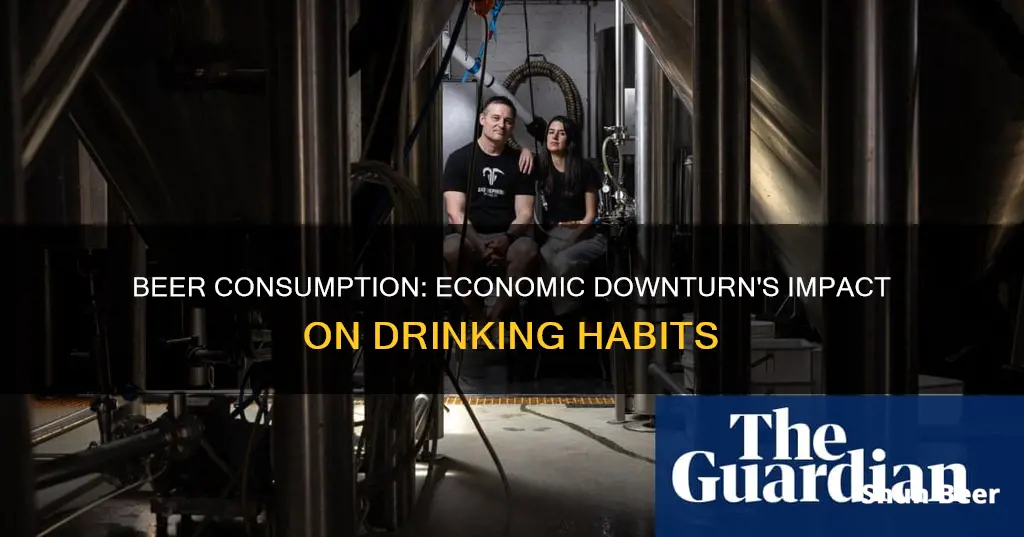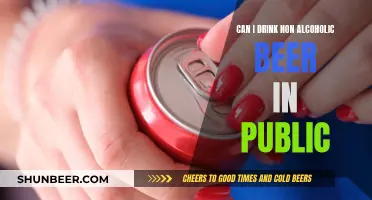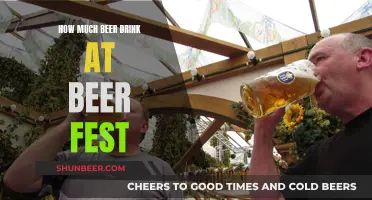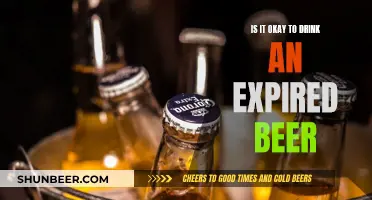
It's a common belief that people turn to alcohol as a coping mechanism during tough economic times. While this may be true for some, the relationship between alcohol consumption and economic downturns is complex and varies across different types of alcoholic beverages. Beer, a popular alcoholic beverage, has seen fluctuating sales during economic recessions, with both increases and decreases in demand depending on various factors. So, let's explore the dynamic relationship between beer consumption and economic downturns to understand if people indeed drink more beer when the economy worsens.
| Characteristics | Values |
|---|---|
| Alcohol consumption during economic downturns | A 2011 study suggests that people drink more alcohol during hard economic times. However, most previous research shows that drinking-related problems tend to decline with the economy. |
| Alcoholism and economic downturns | The 2011 study found a positive correlation between state unemployment rates and alcoholism or alcohol abuse. |
| Alcohol consumption and income | Most studies show that when income decreases, so does drinking, as people have less money to spend on alcohol. |
| Alcohol prices and consumption | Increasing the price of alcohol generally leads to reduced consumption, even among heavy drinkers. |
| Alcohol consumption during historical economic crises | During the Great Depression of 1929 and after, alcohol consumption dropped significantly across countries. |
| Alcohol-related deaths during economic recessions | A study in Finland found that alcohol-related deaths decreased slightly during an economic recession. |
| Substance misuse and unemployment | The National Household Survey on Drug Use and Health consistently finds that rates of substance misuse and addiction are nearly twice as high in unemployed people compared to those with jobs. |
| Beer consumption in the US | Beer is the most widely consumed alcoholic beverage in the US by volume. However, its market share has been declining, with spirit sales surpassing beer sales in 2022. |
| Boutique beer popularity | During economic downturns, consumers may opt for cheaper, high-quality draft beers from small local breweries, known as boutique or craft beers. |
| Alcohol consumption by age group | The percentage of young adults in the US who prefer beer has decreased over time, with a shift towards wine and hard alcohol. |
| Alcohol consumption by generation | Millennials are more likely to purchase alcohol compared to Gen Z, who tend to spend less on alcohol and consume it less regularly. |
| Alcohol consumption and income | There is a positive correlation between annual household income and the percentage of individuals who consume alcohol. |
What You'll Learn
- People may drink more beer during a poor economy, but it's not always the case
- People with less money may opt for cheaper, higher-quality draft beers
- Beer consumption is in decline, but people are paying more for better beer
- Young people are drinking less beer, opting for wine and spirits instead
- People are drinking less overall, but sales of non-alcoholic beverages are rising

People may drink more beer during a poor economy, but it's not always the case
It is often assumed that people turn to alcohol as a coping mechanism during a poor economy. However, the relationship between alcohol consumption and economic downturns is complex and multifaceted. While some studies suggest that people may drink more beer during challenging economic periods, other research indicates that alcohol consumption tends to decline alongside the economy.
A study conducted by researchers at the University of Miami found a positive correlation between state unemployment rates and rates of alcoholism, alcohol abuse, and drunk driving. Their research, which analysed data from over 43,000 people surveyed between 2001 and 2005, revealed that a 1% increase in unemployment corresponded to a 17% increase in alcoholism or alcohol abuse and a 35% increase in drunk driving. This suggests that people may turn to alcohol as a coping mechanism during tough economic times.
However, most previous studies, including research by Robin Room, chair of social research in alcohol at the University of Melbourne, have found that alcohol consumption tends to decrease when the economy is struggling. During the Great Depression of 1929, alcohol consumption dropped significantly. Similarly, during Finland's economic crisis after the breakup of the Soviet Union, alcohol-related deaths decreased slightly. These findings indicate that when incomes decline, people may have less money to spend on alcohol, leading to reduced consumption.
The impact of economic downturns on alcohol consumption may also vary depending on individual factors. While some people may increase their drinking as a form of self-medication during tough times, others may cut back or stop drinking altogether. Additionally, the type of alcohol consumed may also change during economic downturns. For example, during the recession in 2009, Americans opted for cheaper, high-quality draft beers from small local breweries instead of more expensive wine or spirits. This shift towards "boutique beers" created a "perfect storm" for the craft beer industry, with more people turning towards premium beers that were less expensive than other alcoholic drinks.
Furthermore, the relationship between unemployment and alcohol consumption is complex and bidirectional. While unemployment can lead to increased drinking, as seen in the University of Miami study, substance misuse and addiction are also associated with unemployment. People struggling with addiction may face challenges in maintaining employment, creating a cycle where unemployment and substance misuse influence each other.
In conclusion, while some studies suggest that people may drink more beer during a poor economy as a coping mechanism, the overall relationship between alcohol consumption and economic downturns is complex and influenced by various factors. Individual differences, changes in consumer tastes, and the availability of alternative options can all play a role in determining whether people drink more or less beer during challenging economic times.
Beer and Intermittent Fasting: What You Need to Know
You may want to see also

People with less money may opt for cheaper, higher-quality draft beers
During economic downturns, people tend to drink at home instead of at bars or restaurants, and they also tend to opt for more affordable alcoholic beverages. This is especially true for beer, which is often considered a staple or affordable luxury in developed countries like the United States.
When money is tight, people with less money may opt for cheaper, higher-quality draft beers. This trend was observed during the 2009 recession, when Americans chose cheaper, high-quality draft beers from small local breweries over wine and spirits. This shift benefited boutique breweries, which saw an increase in sales of premium draft beers priced at $6 to $8, in contrast to cocktails or glasses of wine that cost twice as much.
The preference for cheaper beer during tough economic times is also reflected in the rise of "subpremium" beers, which are lower in calories and often sold in bulk. While craft beer and more expensive beverages are gaining popularity, cheaper beers still have a significant market share, especially among those who are cash-strapped.
During challenging economic periods, people may be more inclined to purchase lower-priced "below-premium" beers, such as Budweiser and Miller High, malt liquor, and single-serve beers. This behavior aligns with the concept of "inferior goods," where consumers tend to flock to more affordable options when their income decreases.
The decision to opt for cheaper beer may also be influenced by the desire to treat oneself without breaking the bank. Even during economic downturns, people still seek extraordinary experiences and are willing to explore the diverse world of beer, which often offers a more affordable alternative to other alcoholic drinks.
Beer and FODMAP Diet: What You Need to Know
You may want to see also

Beer consumption is in decline, but people are paying more for better beer
While beer consumption is in decline, consumers are increasingly willing to pay more for better beer.
A 2014 study by Goldman Sachs Investment Research found that the percentage of young adults who prefer beer to other alcoholic drinks has fallen drastically over the past two decades. Twenty years ago, nearly three-quarters of 18-29-year-olds said they liked beer best. In 2014, this number had dropped to 40%. A more recent Gallup survey from 2021 found that 60% of US adults drank alcoholic beverages, a decrease from 65% in 2019. The average number of drinks consumed in the previous seven days also decreased, from 4.0 drinks in 2019 to 3.6 drinks in 2021.
However, despite the overall decline in beer consumption, the craft beer market is thriving. The number of craft breweries in the US has grown by nearly 5% in the past five years, and each brewery has increased production by nearly 35% since 2004. Craft beers are attracting new drinkers who would rather pay $6 to $8 for a premium draft than twice as much for a cocktail or glass of wine. As a result, the number of boutique breweries in the US has grown to 1,476, and the craft beer market is expected to continue growing.
The rise of craft beer can be attributed to several factors. Firstly, consumer tastes have evolved, and craft breweries have focused on tastes that were previously underrepresented in the hyper-consolidated beer market, such as hoppy IPAs. Secondly, the craft beer movement took off during the Great Recession, as joblessness created a generation of "necessity entrepreneurs" who opened small-time breweries. Finally, regulatory changes, such as the legalization of home brewing in 1978 and exceptions for small craft breweries to sell beer directly to consumers in taprooms, have also contributed to the growth of the craft beer market.
In conclusion, while beer consumption may be in decline overall, consumers are increasingly willing to pay more for better-quality craft beers. The rise of the craft beer market demonstrates that consumers are moving away from mass-produced beers towards more flavorful and locally produced options.
Beer After Tonsillectomy: What You Need to Know
You may want to see also

Young people are drinking less beer, opting for wine and spirits instead
Young people are increasingly drinking less beer, opting for wine and spirits instead. A study by Goldman Sachs Investment Research found that only 40% of young people aged 18-29 prefer beer, a drastic decline from twenty years ago when nearly three-quarters of this age group chose beer over other alcoholic drinks. This shift in preference has resulted in a decline in beer sales, with beer losing its market share to spirits and wine.
The decline in beer consumption among young people can be attributed to various factors. One reason could be the economic climate, which may limit the time and money they have available to spend on alcohol. Young people today may also be more conscious of alcohol's health risks and the negative consequences of excessive drinking. Additionally, the rise of online technology and social media has changed the way young people socialise, reducing the central role that pubs and clubs once played.
The COVID-19 pandemic also played a role in reducing alcohol consumption among young adults. During the pandemic, social gatherings were restricted, and young people drank less as they weren't going out to bars or parties. This trend continued even after the pandemic, with participants in a study by Carnegie Mellon University consuming 12.8 fewer alcoholic drinks per month than before the pandemic.
The alcohol industry has been responding to these changes by shifting towards no- and low-alcoholic drinks. Beer maker Anheuser-Busch aims to have alcohol-free or low-alcohol drinks account for 20% of its sales by 2025. Molson Coors is also investing in non-alcoholic beverages to keep up with the health and wellness trends led by young adults.
The preference for wine and spirits over beer among young people has had a significant impact on the alcohol industry. While beer remains the most widely consumed alcoholic beverage by volume, its market share has been declining. In 2022, spirit sales overtook beer sales for the first time, highlighting the shifting preferences of consumers.
Ginger Beer Mixology: Creative Cocktails and Mocktails
You may want to see also

People are drinking less overall, but sales of non-alcoholic beverages are rising
People are drinking less alcohol overall, but non-alcoholic beverage sales are on the rise. This shift in consumer behaviour is driven by a variety of factors, including health concerns, changing tastes, and economic conditions.
During the Great Recession, overall alcohol consumption decreased, but a study by the University of Miami found that each 1% increase in the state unemployment rate corresponded to a nearly 17% increase in cases of alcoholism or alcohol abuse. This suggests that some people may turn to alcohol as a coping mechanism during tough economic times. However, most previous studies have found that when income decreases, so does alcohol consumption, as people have less money to spend on alcohol.
The trend away from alcohol is particularly pronounced among young people. According to a Goldman Sachs Investment Research study, only 40% of twenty-somethings prefer beer, compared to 75% two decades ago. Gen Z drinkers also spent 40% less on alcohol than Millennials and made five fewer trips per year to purchase it. They are also more likely to be concerned about the impact of alcohol on their mood, alertness, and social media image.
While overall alcohol consumption is down, the alcoholic beverage industry is evolving to meet changing consumer preferences. Boutique and craft beers have gained popularity, with people opting for cheaper, high-quality draft beers from small local breweries. The number of boutique breweries in the United States has grown by nearly 5% in the past five years, and craft breweries are experimenting with new flavours and ingredients to attract consumers.
However, the beer industry as a whole is facing increasing competition from spirits-based drinks, hard seltzers, and non-alcoholic beverages. Non-alcoholic drinks are gaining market share, with sales of non-alcoholic beverages increasing by 33% over a 52-week period ending in late October 2021. This shift towards non-alcoholic options is driven by a growing consumer interest in health and wellness, with some people opting for low- or no-alcohol drinks to relax and have a good time.
Beer Expiry: Can You Drink Past the Date?
You may want to see also
Frequently asked questions
It depends. Some studies suggest that people drink more alcohol when the economy is doing poorly, while others suggest that alcohol consumption decreases during economic downturns.
People may drink more beer during economic downturns if it is cheaper than other alcoholic beverages. Additionally, people with higher incomes generally consume more alcohol, so a decrease in income may lead to a decrease in alcohol consumption.
It depends on the type of beer. Sales of high-end, craft, and flavored beers have been rising during recessions, while sales of cheap beers may either increase or decrease.
During the COVID-19 pandemic, in-store sales of sub-premium beer rose by more than 11% compared to the same period a year earlier. However, sales of all types of beers also increased, with overall beer sales up by 27.5% in 2020 compared to the previous year.
Macroeconomic factors such as GDP growth, employment rates, and consumer sentiment can impact beer consumption. During economic growth, consumers may have more disposable income to spend on beer products.







